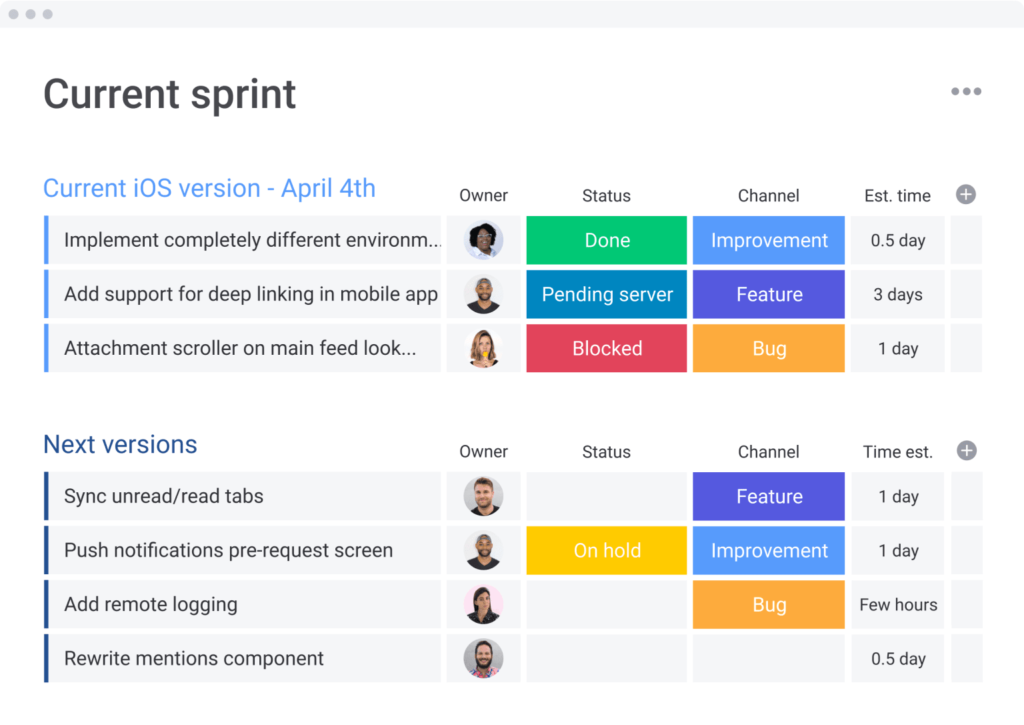What is a project?
The Project Management Institute, a not-for-profit professional organization considered an authority on project management, defines project as a temporary endeavor to create a unique product, service, or result. It encompasses a structured sequence of tasks, activities, and deliverables that are completed to achieve a specific outcome.
An example of a project could be developing a mobile app for a fintech startup, constructing a new bridge, or organizing an international film festival.
What is project management?
Project management is the application of a set of skills, knowledge, methodologies, strategies, and techniques to implement and execute a project and turn an idea into a tangible product, service, or deliverable.
Project management has become an essential part of every business. Many industries have started adopting the practice of strategically managing projects to boost success.
Which industries use project management?
To better conceptualize project management, it helps to know how it plays out in real-life applications.
Here are a few examples of industries that use project management:
Construction

In 2005, BAA Airports Ltd. was presented with an enormous task: remodeling Terminal 1 within Heathrow Airport, the busiest international airport in the world, while keeping the terminal open to the 20 million annual travelers that pass through it. The project was extremely complex and made even more challenging due to strict deadlines and significant public health concerns, given that the construction project occurred within an active terminal.
Throughout the project life cycle, David Buisson, PMP and the project manager in charge of the Heathrow Airport renovation project, encountered many unexpected obstacles, including asbestos in the ceiling and inconsistencies with the floor level.
Buisson and his team were able to properly navigate project challenges, operational risk, and communication management with key stakeholders. They delivered the project on time and on budget — without any major mishaps — using the Project Management Institute’s Project Management Book of Knowledge® Guide, the standard guide for project management professionals.
The 2005 renovation of Heathrow Airport Terminal 1 is widely considered one of the most successful case studies in construction project management to date.
Healthcare

During the COVID-19 pandemic, pharmaceutical and biotechnology company AstraZeneca partnered with the University of Oxford to address the international need for a vaccine. Researchers at Oxford University had begun a promising research around an early vaccine option; at the same time, AstraZeneca had already made a name for their manufacturing capabilities and global supply chain experience. It was not surprising for the two entities to pair up to address the need presented by the pandemic.
However, the partnership would face numerous challenges including, most notably, a highly unpredictable and rapidly worsening public health crisis. Adaptability had to be the name of the game, and the structured guidelines of project management provided a baseline for the team to work from.
Ultimately, the project was an overwhelming success, with over 1 billion vaccine doses delivered to more than 170 countries.
Aerospace technology

The Mars Pathfinder mission began in 1996 as a result of budget cuts within NASA, shifting the organization’s focus to projects that could be completed “faster, better, and cheaper.” The goal was to spend less than $150 million on the project and implement it within 36 months. Based on the initial goals established by NASA, just getting the spacecraft to Mars and landing it in one piece would have been a success.
Instead, by the time the project reached completion in September 1997, the Mars Pathfinder returned 2.3 billion bits of information, including more than 16,500 images from the lander and 550 images from the rover, as well as more than 15 chemical analyses of rocks and soil and extensive data on winds and other weather taking place on Mars.
Ultimately, the project was such an exemplary example of project management at work that it won the Project Management Institute’s coveted Project of the Year Award in 1998.
What is a project manager?
One of the most sought-after roles for anyone seeking to build a career in project management, project managers are the ones who take ownership of the project from its inception through completion. They direct team efforts, navigate day-to-day challenges, implement project management strategies, and more. Ultimately, they are responsible for the submission of key deliverables and the successful execution of the entire project.
Responsibilities of a project manager
Project managers are responsible for a wide range of project-related duties, including but not limited to:
- Establishing and managing the project timeline
- Assigning project tasks and delegating responsibilities to team members
- Communicating with key stakeholders
- Executing each phase of the project
- Facilitating team adaptation of project management aids and tools (such as project management software and Gantt charts)
- Monitoring the project budget and project scope, preventing cost or scope overruns
- Troubleshoot and mitigate potential roadblocks and issues
- Establishing set meeting schedules and facilitating team discussions
- Monitoring project progress
- Concluding the project life cycle with relevant end-of-project responsibilities, including facilitating project reviews, and turning over deliverables
Essential skills for a project manager
Project managers handle various project-related responsibilities and duties and, understandably, need to wield a broad and flexible skillset. Some of the essential skills a project manager should possess include the following:
| Soft Skills | Hard Skills |
|---|---|
| • Leadership • Communication • Teamwork • Organization • Time management • Adaptability • Decision-making • Emotional intelligence • Conflict resolution | • Knowledge and proficiency in project management methodologies • Process management • Risk management • Financial management • Proficiency in relevant tools and software • Data visualization • Scheduling |
Effective project management requires a balanced blend of soft skills and hard skills. While hard skills encompass technical knowledge, methodologies, and tools specific to project management, soft skills are equally crucial for success. These include leadership, communication, problem-solving, and adaptability.
A proficient project manager must be adept at creating schedules, managing budgets, and analyzing risks. They must also excel at motivating teams, resolving conflicts, and navigating stakeholder relationships.
Phases of project management life cycle
PMBOK defines project life cycle as the series of phases a project passes through from conception to completion. The typical project management life cycle consists of five phases: initiation, planning, execution, monitoring, and closure.
1. Project initiation
The project initiation phase focuses on establishing a high-level vision for the project while securing approvals from sanctioning stakeholders. This phase is not meant to dive into excessive detail but rather to get the ball rolling and get the team thinking about what is to come.
2. Project planning
During the project planning phase, teams build upon the vision established in the initiation phase in much more detail. First, teams must answer a few essential questions surrounding what the project will aim to accomplish, how the project will be carried out, when it will begin, on what timeline, and how project success will be measured. After answering these questions, teams can start building out project infrastructure, covering essential topics such as:
- Project scope
- Deliverables
- Key stakeholders
- Goals and milestones
- Resources needed (internally and externally)
- Team roles
- Project timeline
- Potential risks or roadblocks
- Dependencies
- Project outcomes
3. Project execution
The project execution phase is the starring act of the project and is where most of the deliverables come from. During this phase, the project manager coaches and guides the team to present essential project deliverables while keeping stakeholders in the loop and monitoring progress against key milestones and KPIs.
Throughout the project execution phase, project management systems, such as project management software, can help project managers by keeping track of deadlines and deliverables, providing a platform for team collaboration, and more.
4. Project monitoring
During the project monitoring phase, the project manager monitors the project’s progress and the team’s status. Whether teams are on track and delivering stellar results or facing roadblocks and challenges, the project manager can help eliminate stressors, solve problems, and communicate updates with key stakeholders.
5. Project closure
The closing phase of the project management life cycle is a time for wrapping up project activities, finalizing project deliverables, and reflecting on the wins and losses of the project overall. Communication is key during this phase, as it is a time for team members to discuss what they did best and what they could improve on.
Check out the video below for a more in-depth walkthrough of the five phases of the project management life cycle.
You can also download our free project life cycle guide for a quick summary of the actions involved in each stage of the project management process.
Download our FREE project life cycle guide
Project management methodologies
Project management methodologies establish a guiding set of rules and principles that teams can implement to achieve greater efficiency while maximizing positive project outcomes. Each methodology approaches project management differently, providing teams with a specific set of repeatable steps to follow throughout the project life cycle.
Project management frameworks can exist within methodologies, giving a more focused view of how methodology guidelines can be applied and implemented. While the structure and rules follow the teachings of the methodology, frameworks can color in detail how and when those rules work in a project setting.
Agile
Agile project management offers an iterative and highly flexible approach to project management. It focuses on delivering the project in pieces throughout its life cycle, rather than all at once at the project’s conclusion. In agile project management, teams have more flexibility to adapt to challenges and redirections than in more structured methodologies, such as waterfall.
Best for
- Software development teams
- Teams dealing with high levels of uncertainty
- Teams who are creating prototypes that need multiple levels of edits and changes
- Teams working closely with external parties and stakeholders
Waterfall
Waterfall project management is a traditional approach to project management that involves rigid, sequential project phases. In the waterfall model, each phase of the project must be completed before the next phase can begin, and project deliverables are turned over only at the conclusion of the project.
Best for:
- Projects with a well-defined goal
- Projects with concrete timelines
- Teams who need to define rigid project requirements early on
Project management frameworks
Scrum
Scrum project management is a subset of the much broader agile umbrella. As its name suggests, Scrum is inspired by the camaraderie and teamwork in the sport of rugby. Led by a Scrum master, Scrum teams are encouraged to learn through their experiences, self-organize as they problem-solve, and progress throughout the project life cycle.
Best for:
- Smaller teams tackling numerous unknowns and ever-changing variables
- Teams who are creating prototypes that need multiple levels of edits and changes
- Teams working closely with external parties and stakeholders
Project example: Application development
The Scrum methodology is an excellent framework for application development. As an agile framework, it follows an iterative and incremental approach, helping development teams adapt quickly to changing requirements and deliver functional software in short sprints. It allows for extensive user testing and adjustments based on their needs and preferences.
Scrum also allows cross-functional teams to maximize all expertise. By emphasizing collaboration, transparency, and continuous improvement, Scrum fosters a highly productive environment.
The framework’s key elements, also known as ceremonies — such as daily stand-ups, sprint planning, and retrospectives — ensure constant communication and rapid feedback, enabling teams to identify and resolve issues promptly. This agile approach not only accelerates the development process but also enhances the quality of the final product.
| When to use Scrum | When not to use Scrum |
|---|---|
| • Complex projects with changing requirements • Rapid iterations and frequent feedback needed • Cross-functional teams that can self-organize | • Simple, predictable projects • When teams can’t commit to regular sprints • Highly regulated environments with strict documentation requirements • Projects with fixed scopes and deadlines |
Kanban
The Kanban framework is a subset of the agile methodology that emphasizes continuous improvement and flexible task management. In the Kanban framework, teams utilize Kanban boards, which are vertical boards that separate individual task cards into categories based on their status in the project life cycle (for example: “not started,” “in progress,” and “completed”).
Best for:
- Teams who are new to project management and looking for a simple, organized framework
- Projects with numerous individual tasks and assignments
- Teams who need quick access to a high-level view of task overviews and completion status
Project example: Content management
Kanban is an ideal methodology for content creation and management due to its visual and flexible nature. By using a Kanban board, content teams can easily visualize their workflow, from ideation to publication, allowing for better task prioritization and workload management.
The system’s focus on limiting work-in-progress helps prevent bottlenecks and ensures a steady content production flow. Kanban’s adaptability allows teams to respond quickly to changing priorities or urgent content needs without disrupting the entire workflow. Additionally, its emphasis on continuous delivery aligns well with the dynamic nature of content creation, enabling teams to maintain a consistent output while continuously improving their processes.
| When to use Kanban | When not to use Kanban |
|---|---|
| • Ongoing work with a continuous flow • Maintenance or support environments • Flexibility in prioritization is needed • Focus is on reducing cycle time and improving efficiency | • When fixed time-boxed iterations required and need to be tracked • Projects with complex dependencies • Environments where work can’t be easily visualized on a board • When extensive planning and estimates are necessary |
Critical path method (CPM)
Critical path method is a project management concept referring to the framework within the waterfall methodology that identifies critical and non-critical tasks, prioritizing them based on their importance — eliminating bottlenecks and roadblocks. The CPM method emphasizes the importance of calling out relationships between tasks and task dependencies.
Best for:
- Teams managing large, complex projects
- Projects that require a large number of tasks with subtasks and dependencies
- Teams who want to maximize efficiency and prevent roadblocks from the start of the project (especially for projects that have a high likelihood of complication)
Project example: Large-scale event management
The critical path method is particularly well-suited for large-scale event management due to its focus on identifying and prioritizing crucial tasks based on dependencies.
In complex events with numerous interdependent activities, CPM helps managers determine the longest sequence of tasks (the critical path) that must be completed on time for the event to succeed. This method allows event planners to allocate resources efficiently, identify potential setbacks, and create contingency plans for high-priority tasks.
By visualizing the entire event timeline and understanding task dependencies, managers can make informed decisions about scheduling, resource allocation, and risk mitigation.
| When to use CPM | When not to use CPM |
|---|---|
| • Large, complex projects with interdependent tasks • Precise scheduling and resource allocation are crucial • Projects with fixed deadlines and task dependencies | • Small, simple projects • Rapidly changing environments • Flexibility is more important than strict scheduling • Creative or research-based projects with unpredictable outcomes |
PRINCE2
PRojects IN Controlled Environments, or PRINCE2, is a framework within the Waterfall project management methodology that emphasizes organization and control. Frequently used in the UK and internationally, The PRINCE2 model breaks down projects into smaller, more manageable chunks in order to manage risk and resources while clearly defining team roles and responsibilities.
Best for:
- Teams who have less experience in project management (PRINCE2 follows clearly defined, easy-to-understand steps)
- Teams who need more clarity around specific role-based responsibilities
- Compartmentalizing project steps and actions
Project example: Editorial project management
PRINCE2 (PRojects IN Controlled Environments) is particularly effective for editorial project management due to its structured and adaptable approach. This methodology’s emphasis on clear roles and responsibilities aligns well with the hierarchical nature of editorial teams, ensuring that editors, writers, and other stakeholders understand their specific duties.
PRINCE2’s focus on product-based planning is ideal for managing various editorial deliverables such as drafts and book chapters. Its stage-gate approach allows for regular quality checks and approvals, which is crucial in maintaining editorial standards.
Additionally, PRINCE2’s principle of managing by exception enables senior editors to delegate effectively while maintaining oversight on critical issues, making it an excellent choice for complex editorial projects with multiple stakeholders and tight deadlines.
| When to use Prince2 | When not to use Prince2 |
|---|---|
| • Large, complex projects • Highly regulated industries or government sectors • Clear governance and accountability are required • Projects with multiple stakeholders and strict reporting needs | • Small, agile projects • Startups or fast-paced environments • Extensive documentation is seen as overhead • Teams that prefer self-organization over hierarchical management |
Project management tools
Project management software
Project management software helps teams organize all project essentials in one place, streamlining and simplifying the project management process overall. At every phase of the project life cycle, project management software supports teams’ ability to assign tasks, manage deadlines, view task dependencies, track team progress against goals, access data insights, and much more.
